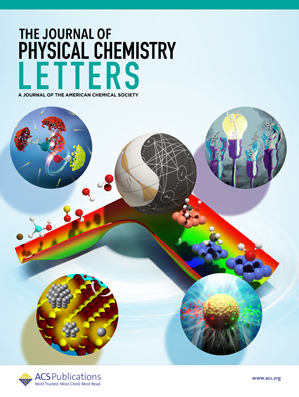Correction to “Remarkable Insensitivity of Protein Diffusion to Protein Charge”
IF 4.8
2区 化学
Q2 CHEMISTRY, PHYSICAL
引用次数: 0
Abstract
Calculations of diffusion constants from molecular dynamics (MD) simulations require finite-size corrections. (1) The diffusion constant DMD calculated with periodic boundary conditions (PBC) employed in MD needs correction for hydrodynamic effects of viscous solvent flow within the lattice of periodically replicated images of the tagged diffusive particle. For a cubic simulation box of length L, one obtains the diffusion constant of the infinite system D from the PBC value DMD according to the following equation. (1) We have recently reported MD simulations of the diffusion constants of two proteins, green fluorescent protein (GFP) and plastocyanin (PC), in TIP3P water. (3) The finite-size term in eq 1 was incorrectly calculated, and the corrected D values in Table 2 of ref (3) were close to the MD values DMD. When we re-examined the reported values, we noticed that D ≃ 257 μm2/s from eq 1 significantly exceeds DMD ≃ 20.8 μm2/s for the system size of L ≃ 86 Å (≃18,000 TIP3P water molecules). The finite-size correction, ≃236 μm2/s, is thus significantly higher than the MD result itself (η = 0.306 cP for TIP3P water (4) was applied in eq 1). Given approximations involved in deriving the correction term, (1) this observation puts under doubt the validity of D calculated according to eq 1. Here, we present additional data from MD simulations of GFP and PC diffusion in simulation boxes of different size to show that eq 1 highly overestimates D(L) (Figure 1 and Table 1). The MD simulation protocol follows ref (3), with modifications to the box size and the number of water molecules. From charge mutants studied in ref (3), only the wild-type GFP with a charge of −6 is considered here. PC is in its reduced state with the charge of −9. We find strongly divergent values of D(L) and DMD(L) (Figure 1), while extrapolation to L–1 → 0 gives consistent results for D(∞) and DMD(∞) (black dots in Figure 1). Figure 1. DMD(L) (blue) and size-corrected D(L) (red, eq 1) vs L–1 for GFP and PC proteins. The solid lines are linear fits of the MD results (points). The black dots indicate crossing of two interpolations to the infinite-size limit L–1 → 0. Equilibrium trajectories for 50 ns, with dynamics calculated from 10 ns trajectories with the integration time of 1 fs and saving time of 5 fs. Same simulation parameters for PC, except for 100 ns equilibration trajectories. Variations between DF(L) data points are caused by corresponding variations in the force variance since τm is independent of L. DF refers to eq 2. We have also calculated diffusion constants from the dynamics of the force F acting on the protein from water. (5−7) D is calculated from the corrected (3,7) Kirkwood equation in which the memory function relaxation time τm replaces the force relaxation time in the original formulation (5) This research was supported by the National Science Foundation (CHE-2154465). This work used CPU resources through allocation MCB080071 from the Advanced Cyberinfrastructure Coordination Ecosystem: Services & Support (ACCESS) program and through ASU’s Research Computing. This article references 10 other publications. This article has not yet been cited by other publications.

求助全文
约1分钟内获得全文
求助全文
来源期刊

The Journal of Physical Chemistry Letters
CHEMISTRY, PHYSICAL-NANOSCIENCE & NANOTECHNOLOGY
CiteScore
9.60
自引率
7.00%
发文量
1519
审稿时长
1.6 months
期刊介绍:
The Journal of Physical Chemistry (JPC) Letters is devoted to reporting new and original experimental and theoretical basic research of interest to physical chemists, biophysical chemists, chemical physicists, physicists, material scientists, and engineers. An important criterion for acceptance is that the paper reports a significant scientific advance and/or physical insight such that rapid publication is essential. Two issues of JPC Letters are published each month.
 求助内容:
求助内容: 应助结果提醒方式:
应助结果提醒方式:


